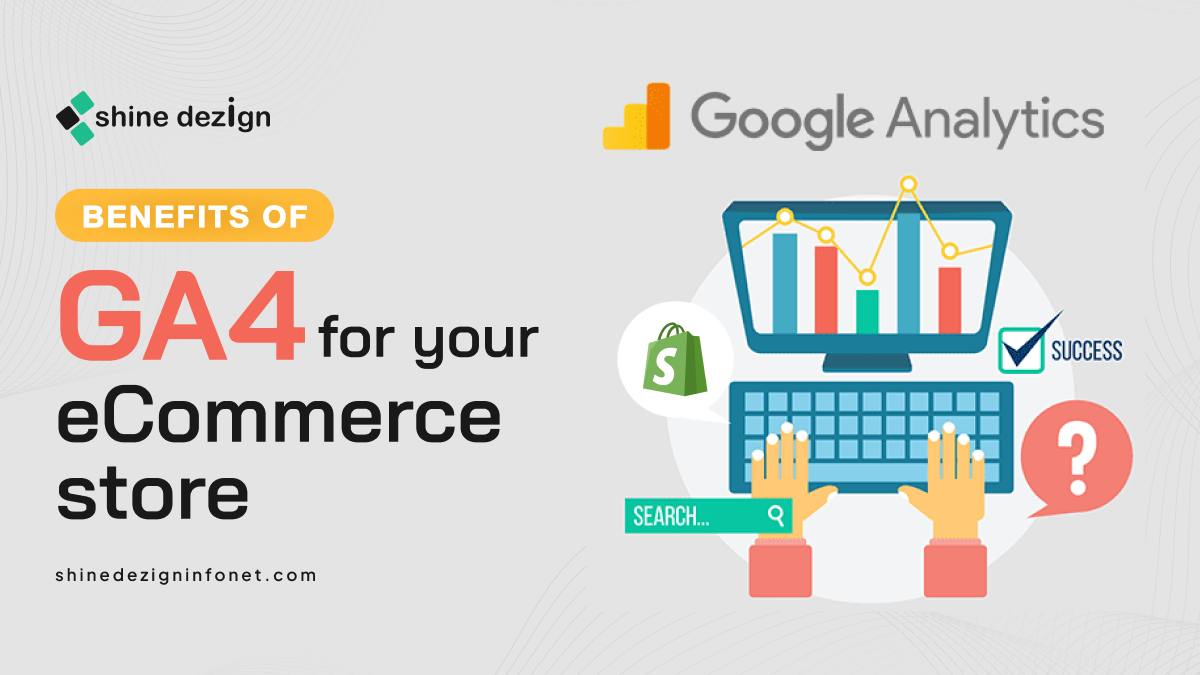Table of Contents
- Introduction
- What is Google Analytics4?
- Advantages of Google Analytics for your eCommerce Store
- Extensive Data Gathering
- Enhanced Tracking and Reporting
- Enhanced Marketing Campaigns
- Optimization of Conversion Rate
- Site Performance Optimization
- How can you configure a Google Analytics report for your Shopify Store?
- Strategies for Enhancing Your Google Analytics Configuration
- Summing Up
Google Analytics is a leading analytics service that aids in the digital transformation of businesses. Moreover, Google Analytics for eCommerce offers a powerful suite of tools designed to track and gather customer insights, enabling businesses to improve website functionality, increase profits, and thrive in a competitive marketplace.
The most recent update, Google Analytics 4 (GA4), showcases the capabilities of Google’s analytics features. Hence, in this article, we will delve into the advantages of Google Analytics and guide you on how to integrate Google Analytics into your Shopify Store.
What is Google Analytics4?
Google Analytics is a web analytics service that offers tools and data for website performance. It helps website and business owners measure traffic and engagement on their apps and websites. Many eCommerce organizations utilize this data for SEO improvement and marketing campaigns, as well as to better understand their target audience and how they seamlessly operate online.
In contrast to the original Google Analytics, also referred to as universal analytics, there are several modifications to note. These encompass the following:
-3 user metrics (Total users, Active users, and New users) with Active users being the latest metric introduced. This metric denotes the number of unique users who visit a website.
-GA4 amalgamates page views to include both app and web data, whereas universal analytics records screen views in distinct properties.
– Universal Analytics accommodates goal types while GA4 caters to key events.
Advantages of Google Analytics for your eCommerce Store
Google Analytics presents a plethora of benefits for an e-commerce store. It delivers crucial insights that can assist businesses in enhancing their online store and effortlessly increase sales. Let’s explore the primary advantages.
1. Extensive Data Gathering
A primary benefit of Google Analytics for eCommerce is its capacity to provide comprehensive information about the geographical locations of visitors. It also delivers in-depth data regarding the age, gender, and interests of users who effortlessly navigate your website.
For instance, if you find out that millennials in a particular area are drawn to beauty and fashion items, you can leverage this information from Google Analytics to develop and advertise content that directly appeals to this audience.
Google Analytics provides insights into user behavior, detailing how visitors engage with your site. It offers data such as the number of pages viewed and the duration of visits, areas that might require enhancement. By scrutinizing and interpreting these patterns, you can effortlessly refine your website’s content and layout to maintain user engagement and guide them smoothly through the sales process.
2. Enhanced Tracking and Reporting
Google Analytics eCommerce Tracking enables you to effortlessly monitor and evaluate product performance by tracking indicators like conversion rates, revenue, and individual product sales. This information is vital for pinpointing the most recommended product and also aids in comprehending customer preferences.
Tailored reports allow you to focus on the key metrics that are crucial for your business. So, whether your interest lies in traffic origins, sales efficiency, or user activity, you can effortlessly customize your reports to offer the necessary insights for making educated decisions.
These reports can be easily delivered, helping you stay upgraded and updated on your Shopify Store performance.
Additionally, Google Analytics offers the powerful feature of real-time data. This allows you to view your website’s latest traffic and user activity, providing instant feedback on the effectiveness of marketing initiatives or website modifications. These real-time insights enable you to swiftly identify and address emerging issues or trends, thereby optimizing your site’s performance without delay.
3. Enhanced Marketing Campaigns
Google Analytics is often viewed as an expert tool for steering your marketing efforts. As such, it allows you to effortlessly determine which channels are bringing the most crucial and valuable traffic to your website by assessing the sources of traffic.
Nonetheless, tracking campaigns is crucial for comprehending the effectiveness of a particular marketing endeavor. Whether you’re utilizing Google Ads, social media, or email marketing, you can effortlessly track and analyze click-through rates (CTA), conversion rates, and cost per acquisition, enabling you to formulate marketing strategies to enhance outcomes.
A/B testing is another significant element for improving marketing campaigns. Hence, Google Analytics provides you with the ability to conduct A/B tests to effortlessly classify and contrast different versions of your website or marketing approaches. As such, it’s critical to test variations of headlines, CTAs, and other important components.
4. Optimization of Conversion Rate
Boosting conversion rates is crucial, and this can be achieved by refining the sales funnel. Google Analytics provides comprehensive insights into the critical stages of the sales funnel, from the initial visit to the final purchase. This allows you to examine your users’ bounce rate and tackle any potential obstacles to conversion.
Furthermore, Google Analytics allows you to set specific objectives such as completed purchases, form submissions, and more. By scrutinizing these metrics, you can effectively assess your website’s performance and make necessary adjustments.
Moreover, the visualization of user flow is an additional effective tool for enhancing conversion rates. This feature allows you to visualize the routes that users take on your website, helping you understand the navigation process and identify potential issues. By pinpointing these problem areas, you can make improvements to enhance your user experience.
5. Optimizing Site Performance
Website load speed plays a crucial role in user experience and conversion rates. Google Analytics offers comprehensive data on your website’s load times, enabling you to identify and address areas that need improvement. By enhancing your website’s performance, you can reduce bounce rates and engage your visitors more effectively, leading to increased conversions.
In addition to website optimization, mobile optimization is also a critical aspect of site performance. Given that a significant number of eCommerce consumers use mobile devices, it’s essential to optimize your website for mobile to provide a smooth user experience.
Google Analytics for eCommerce allows you to understand how mobile users interact with your site, enabling you to make necessary adjustments to enhance performance and usability on mobile devices.
How can you configure a Google Analytics report for your Shopify Store?
Establishing Google Analytics for a Shopify store is an essential process to obtain valuable data about your website’s performance, user activity, and sales statistics. Here is a comprehensive guide on how to accomplish this:
Step 1: Establish a Google Analytics Account
I. Register for Google Analytics:
– Navigate to [Google Analytics] (https://analytics.google.com/).
– Log in using your Google account. If you don’t possess one, create a new Google account.
– Click on “Start for free” to establish a new Google Analytics account.
II. Configure Your Account
– In the “Account setup” section, input a name for your account. This could be the name of your business.
– Select your data sharing settings according to your preference.
– Click “Next” to proceed to the Property setup.
III. Configure Your Property:
– Input a name for your property, like your website name.
– Choose your reporting time zone and currency.
– Click “Next”.
IV. Input Business Details:
– Pick your business sector and size.
– Decide how you plan to utilize Google Analytics for your business.
– Hit the “Create” button.
V. Consent to the Service Terms:
– Go through Google’s service terms.
– Tick the box to agree to the terms and conditions.
– Press “I Accept”.
Step 2: Obtain Your Tracking ID
I. Acquire Your Tracking Code:
– Once your property is set up, you’ll be directed to the “Web Stream Details” page.
– Here, you’ll locate your “Measurement ID” beginning with “G-” (for GA4) or your “Tracking ID” (for Universal Analytics which begins with “UA-”).
Step 3: Implement Google Analytics on Your Shopify Store
I. Sign In to Your Shopify Admin:
– Access your Shopify admin dashboard.
II. Proceed to Online Store Settings:
– From your Shopify admin, navigate to “Online Store” and then select “Preferences”.
III. Insert Your Google Analytics Code:
In the section for Google Analytics, insert your tracking ID.
If Universal Analytics is your choice, input the full “UA-XXXXXXXXX-X” tracking ID.
For GA4 users, the Measurement ID is required.
Click on “Save”.
IV. Activate Enhanced Ecommerce (only for Universal Analytics users):
After saving, an option to “Use Enhanced Ecommerce” will appear. Tick this box and hit “Save”.
Step 4: Confirm Your Setup
I. Check in Google Analytics:
Return to your Google Analytics account.
In the left sidebar, select “Real-time” and then “Overview”.
– Visit your Shopify store in another browser tab or window. You should see real-time data of your visit reflected in Google Analytics, indicating that tracking is working.
Step 5: Set Up Goals in Google Analytics
I. Establish Goals:
In Google Analytics, click the “Admin” gear icon located at the bottom left.
In the “View” column, select “Goals”.
Select “New Goal” to establish specific objectives for your Shopify shop. Typical eCommerce objectives include:
– Destination: Monitor when a user lands on a particular page, such as the “Thank You” page following a transaction.
– Duration: Monitor when a user spends a specific duration on your website.
– Pages/Screens per session: Monitor when a user views a certain number of pages.
II. Define Goal Details:
– Choose a template or custom option depending on your unique tracking requirements.
– Specify the goal details, like the destination URL for completed purchases.
– Hit “Save”.
Step 6: Activate Ecommerce Tracking
I. Turn on E-commerce Reporting:
– In Google Analytics, navigate to “Admin”.
– In the “View” column, select “Ecommerce Settings”.
– Switch on “Enable Ecommerce” and hit “Next”.
– If not already activated, switch on “Enable Enhanced Ecommerce Reporting”.
– Press “Submit”.
Step 7: Implement Enhanced Ecommerce in Shopify
I. Activate Enhanced Ecommerce:
– Return to your Shopify administration panel.
– Under “Preferences” in the “Online Store”, make sure the “Use Enhanced Ecommerce” option is checked.
Step 8: Observe and Evaluate Your Data
I. Utilize Google Analytics Reports:
– Browse various reports in Google Analytics to assess your store’s performance.
– Essential reports for eCommerce stores encompass:
– Audience: Gain insights into your visitors’ demographics.
– Acquisition: Discover the origin of your visitors.
– Behavior: Understand how visitors engage with your store.
– Conversions: Monitor sales and revenue information.
Strategies for Enhancing Your Google Analytics Configuration
1. Connect Google Ads to Google Analytics:
– If you’re utilizing Google Ads, integrate it with Google Analytics for a more detailed understanding of your ad effectiveness and user behavior after clicking.
2. Establish Custom Alerts:
– In Google Analytics, create custom alerts to inform you about significant shifts in traffic, conversion ratios, or other crucial metrics.
3. Implement UTM Parameters:
– Incorporate UTM parameters in your promotional campaigns to monitor the performance of various channels and initiatives.
Summing Up
Ranging from valuable user data analysis to comprehensive tracking, Google Analytics offers the high-quality data and insights required to propel success. Hence, by integrating Google Analytics, e-commerce enterprises can amplify their business efficiency, stimulate business expansion, and enhance ROI.

















